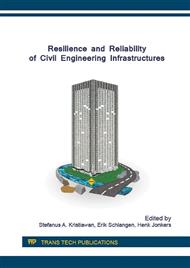p.119
p.126
p.132
p.140
p.148
p.154
p.158
p.166
p.175
Experimental Investigation of Trapezoidal Profile Sheeting under Varying Shear Spans
Abstract:
Composite construction method has been mainly popular due to its faster, lighter and economical methods in high rise buildings. Composite deck slab consisting of two different components, concrete being good in compression placed at the upper portion and the cold form profiled sheeting being good in resistance to tension is placed at the bottom of the deck slab. Composite slab being a combination of two different components, wide researches have been carried out to enhance the structural behavior and material properties. In this paper, trapezoidal profiled sheeting is utilized and constant geometrical dimensions are preferred throughout the study. Specimen consists of totally six numbers of trapezoidal profiled composite slabs cast using M20 grade concrete according to the recommendations of Euro code 4. Load-deflection behavior is keenly observed and recorded using the dial gauges and LVDT’s (Linear Variable differential Transducers) for comparison. When subjected to monotonic loading the composite slab specimens showed different behavioral changes in the structure at various load intervals. Out of the six specimens tested, three slabs at shorter shear spans exhibited failure at shear mode and three slabs tested at longer shear spans exhibited failure at flexure mode.
Info:
Periodical:
Pages:
148-153
Citation:
Online since:
July 2016
Authors:
Price:
Сopyright:
© 2016 Trans Tech Publications Ltd. All Rights Reserved
Share:
Citation:


